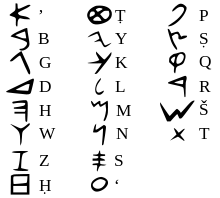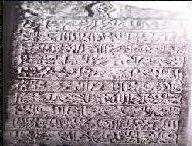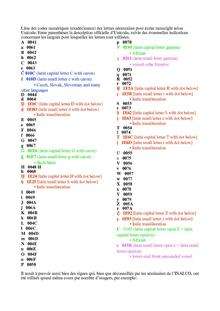Writing systems of Africa

The writing systems of Africa refer to the current and historical practice of writing systems on the African continent, both indigenous and those introduced.
Today, the Latin script is commonly encountered across Africa, especially Sub-Saharan Africa. Arabic script is mainly used in North Africa and Ge'ez/Ethiopic Script is dominant in the Horn of Africa. Regionally and in some localities, other scripts may be of significant importance.
Indigenous writing systems
Ancient orthographies
Ancient Egyptian
Perhaps the most famous writing system of the African continent is ancient Egyptian hieroglyphs. These developed later into forms known as Hieratic, Demotic and Coptic. The Coptic language is still used today as the liturgical language in the Coptic Orthodox Church of Alexandria and the Coptic Catholic Church of Alexandria. The Bohairic dialect of Coptic is used currently in the Coptic church. Other dialects include Sahidic, Akhmimic, Lycopolitan, Fayyumic, and Oxyrhynchite.
Ancient Meroitic
The Meroitic language was spoken in Meroë and the Sudan during the Meroitic period. It was native to the Kingdom of Kush (modern day Sudan). It was used from 300 BCE to 400 CE.
Old Nubian
Old Nubian is an ancient variety of Nubian, used from the 8th to the 15th century. Old Nubian is written in an uncial variant of the Coptic alphabet.
Tifinagh
The Tifinagh alphabet is still actively used to varying degrees in trade and modernized forms for writing of Berber languages (Tamazight, Tamashek, etc.) of the Maghreb, Sahara, and Sahel regions (Savage 2008).
Neo-Tifinagh is encoded in the Unicode range U+2D30 to U+2D7F, starting from version 4.1.0. There are 55 defined characters, but there are more characters being used than those defined. In ISO 15924, the code Tfng is assigned to Neo-Tifinagh.
Ge'ez

The Ge'ez script is an abugida that was developed in the Horn of Africa for writing the Ge'ez language. The script is used today in Ethiopia and Eritrea for Amharic, Tigrinya, and several other languages. It is sometimes called Ethiopic, and is known in Ethiopia as the fidel or abugida (the actual origin of the 21st century linguistic term "abugida", which apply to scripts of India).
Ge'ez or Ethiopic has been computerized and assigned Unicode 3.0 codepoints between U+1200 and U+137F (decimal 4608–4991), containing the basic syllable signs for Ge'ez, Amharic, and Tigrinya, punctuation and numerals.
Nsibidi
Nsibidi (also known as "nsibiri",[1] "nchibiddi", and "nchibiddy"[2]) is a system of symbols indigenous to what is now southeastern Nigeria that is apparently an ideographic script, though there have been suggestions that it includes logographic elements.[3] The symbols are at least several centuries old: Early forms appeared on excavated pottery as well as what are most likely ceramic stools and headrests from the Calabar region, with a range of dates from 400 to 1400 CE.[4][5]
Modern orthographies
East Africa
The Luo script was developed to write Dholuo in Kenya in 2009.
Horn of Africa

Writing systems developed in the twentieth century for transcribing Somali include the Osmanya, Borama and Kaddare alphabets, which were invented by Osman Yusuf Kenadid, Sheikh Abdurahman Sheikh Nuur and Hussein Sheikh Ahmed Kaddare, respectively.[6] The Osmanya script is today available in the Unicode range 10480-104AF [from U+10480 - U+104AF (66688–66735)].
Other writing systems have also been used over the years by different Horn communities. The latter include Sheikh Bakri Sapalo's script for Oromo.[7]
Southern Africa
- In Southern Africa, the Mwangwego alphabet is used to write Malawian languages.[8]
- IsiBheqe SoHlamvu (Bheqe Syllabary), also known as Ditema tsa Dinoko, is a featural syllabary used to write Southern Bantu languages.[9][10]
- The Mandombe script was invented by Wabeladio Payi in 1978 in the Democratic Republic of the Congo. It is apparently promoted by the Kimbanguist Church and used for writing Kikongo, Lingala, Tshiluba, Swahili, and other languages.
West Africa
There are various other writing systems native to West Africa [11] and Central Africa.[12] In the last two centuries, a large variety of writing systems have been created in Africa (Dalby 1967, 1968, 1969). Some are still in use today, while others have been largely displaced by non-African writing such as the Arabic script and the Latin script. Below are non-Latin and non-Arabic-based writing systems used to write various languages of Africa.
The Bamum (Bamun; also Shumom) system of pictographic writing was invented beginning in the late 19th century by Sultan Njoya Ibrahim for writing the Bamun language in what is now Cameroon. It quickly developed into a syllabary. It is rarely used today, but a fair amount of material written in this script still exists.[13]
Other modern writing systems developed in West Africa include:
- The Adlam alphabet developed for writing the Fula language, mostly used in Guinea
- The Akagu alphabet designed for the Igbo language, used to supplement modernized Nsibidi characters[14]
- Bassa alphabet[15] of Liberia
- Bété syllabary of Ivory Coast
- The Eghap script was used by the Bagam (Tuchscherer 1999, Rovenchak 2009).[16] of Cameroon
- Kpelle syllabary[17] of Liberia and Guinea
 The N'Ko alphabet.
The N'Ko alphabet. - Loma syllabary[18] of Liberia and Guinea
- Mandombe script, invented by Wabeladio Payi in the Bas-Congo province of the Democratic Republic of the Congo
- The Mende Ki-ka-ku or KiKaKui syllabary, invented by Kisimi Kamara in Sierra Leone in the early 20th century. It is still used.[19]
- N'Ko, invented in 1949 by Solomana Kante in Guinea, primarily for the Manding languages. It is apparently in increasing use in West Africa, including some efforts to adapt it to other languages (Wyrod 2008).[20]
- The Nwagu Aneke syllabary invented in the 1950s for the Igbo language of southeastern Nigeria
- The Vai syllabary invented by Mɔmɔlu Duwalu Bukɛlɛ for the Vai language in what is now Liberia during the early 19th century. It is still used today.[21]
- Zaghawa (Beria) of Darfur and Chad, created in 2000 from an earlier proposal made from livestock brands.
Introduced and adapted writing systems

Most written scripts, including Greek, Hebrew, and Arabic, were based on previous written scripts and the origin of the history of the alphabet is ultimately Egyptian Hieroglyphs, through Proto-Sinaitic or Old Canaanite. Many other indigenous African scripts were similarly developed from previous scripts.
Phoenician/Punic
The Phoenicians from what is now Lebanon traded with North Africans and founded cities there, the most famous being Carthage. The Phoenician alphabet is thought to be the origin of many others, including: Arabic, Greek, and Latin. The Carthaginian dialect is called Punic.[22] Today's Tifinagh is thought by some scholars to be descended from Punic, but this is still under debate.
Greek
The Greek alphabet was adapted in Egypt to the Coptic alphabet and language (which is today only a liturgical language of the Coptic Church). The latter alphabet was in turn adapted to what is now called the Coptic alphabet, with the addition of 7 letters derived from ancient Demotic.
Arabic

The Arabic script was introduced into Africa by the spread of Islam and by trade. Apart from its obvious use for the Arabic language, it has been adapted for a number of other languages over the centuries. The Arabic script is still used in some of these cases, but not in others.
It was often necessary to modify the script to accommodate sounds not represented in the script as used for the Arabic language. The adapted form of the script is also called Ajami, especially in the Sahel, and sometimes by specific names for individual languages, such as Wolofal, Sorabe, and Wadaad writing. Despite the existence of a widely known and well-established script in Ethiopia, there are a few cases where Muslims in Ethiopia have used the Arabic script, instead, for reasons of religious identity.
There are no official standard forms or orthographies, though local usage follows traditional practice for the area or language. There was an effort by ISESCO to standardize Ajami usage. Some critics believe this relied too much on Perso-Arabic script forms and not enough on existing use in Africa. In any event, the effect of that standardization effort has been limited.
Latin

The first systematic attempts to adapt the Latin script to African languages were probably those of Christian missionaries on the eve of European colonization (Pasch 2008). These however were isolated, done by people without linguistic training, and sometimes resulted in competing systems for the same or similar languages.
One of the challenges in adapting the Latin script to many African languages was the use in those tongues of sounds unfamiliar to Europeans and thus without writing convention they could resort to. Various use was made of letter combinations, modifications, and diacritics do represent such sounds. Some resulting orthographies, such as the Yoruba writing system established by the late 19th century, have remained largely intact.
In many cases, the colonial regimes had little interest in the writing of African languages, but in others they did. In the case of Hausa in Northern Nigeria, for instance, the colonial government was directly involved in determining the written forms for the language.
Since the colonial period, there have been efforts to propose and promulgate standardized or at least harmonized approaches to using the Latin script for African languages. Examples include the Standard Alphabet by Lepsius (mid-19th century) and the Africa Alphabet of the International Institute of African Languages and Cultures (1928, 1930).
Following independence there has been continued attention to the transcription of African languages. In the 1960s and 1970s, UNESCO facilitated several "expert meetings" on the subject, including a seminal meeting in Bamako in 1966, and one in Niamey in 1978. The latter produced the African reference alphabet. Various country-level standardizations have also been made or proposed, such as the Pan-Nigerian Alphabet. A Berber Latin alphabet for northern Berber includes extended Latin characters and two Greek letters.
Such discussions continue, especially on more local scales regarding cross-border languages.
Office/computer technology, fonts and standards
Typewriters
There is not much information on the adaptation of typewriters to African language needs (apart from Arabic, and the African languages that do not use any modified Latin letters). There were apparently some typewriters fitted with keys for typing Nigerian languages. There was at least one IBM Selectric typewriter "typeball" developed for some African languages (including Fula).
Around 1930, the English typewriter was modified by Ayana Birru of Ethiopia to type an incomplete and ligated version of the Amharic alphabet.[23]
The 1982 proposal for a unicase version of the African reference alphabet made by Michael Mann and David Dalby included a suggested typewriter adaptation.[24]
Early computing and fonts
With early desktop computers it was possible to modify existing 8-bit Latin fonts to accommodate specialized character needs. This was done without any kind of system or standardization, meaning incompatibility of encodings.
Similarly, there were diverse efforts (successful, but not standardized) to enable use of Ethiopic/Ge'ez on computers.
Current standards
There was never any ISO 8859 standard for any African languages apart from ISO 8859-6 for (standard) Arabic. One standard – ISO 6438 for bibliographic purposes – was adopted but apparently little used (curiously, although this was adopted at about the same time as the African reference alphabet, there were some differences between the two, indicating perhaps a lack of communication between efforts to harmonize transcription of African languages and the ISO standards process).
Unicode in principle resolves the issue of incompatible encoding, but other questions such as the handling of diacritics in extended Latin scripts are still being raised. These in turn relate to fundamental decisions regarding orthographies of African languages.
In recent years, Osmanya, Tifinagh and N'Ko have been added to Unicode, as have individual characters to other ranges, such as Latin and Arabic. Efforts to encode other African scripts, including minority scripts and major historical writing systems like Egyptian hieroglyphs, are being coordinated by the Script Encoding Initiative.
Notes
- ↑ Elechi, O. Oko (2006). Doing justice without the state: the Afikpo (Ehugbo) Nigeria model. CRC Press. p. 98. ISBN 0-415-97729-0.
- ↑ Diringer, David (1953). The alphabet: a key to the history of mankind. Philosophical Library. pp. 148–149.
- ↑ Gregersen, Edgar A. (1977). Language in Africa: an introductory survey. CRC Press. p. 176. ISBN 0-677-04380-5.
- ↑ Slogar, Christopher (Spring 2007). "Early ceramics from Calabar, Nigeria: Towards a history of Nsibidi.". African Arts. University of California. 40 (1): 18–29. doi:10.1162/afar.2007.40.1.18.
- ↑ Slogar, Christopher (2005). Eyo, Ekpo, ed. Iconography and Continuity in West Africa: Calabar Terracottas and the Arts of the Cross River Region of Nigeria/Cameroon (PDF). University of Maryland. pp. 58–62.
- ↑ Laitin (1977:86–87)
- ↑ Hayward and Hassan, "The Oromo Orthography of Shaykh Bakri Saṗalō", Bulletin of the School of Oriental and African Studies, 44 (1981), p. 551
- ↑ "Mwangwego". Omniglot.com. 1997-04-07. Retrieved 2013-11-26.
- ↑ "Isibheqe Sohlamvu: An Indigenous Writing System for Southern Bantu Languages" (PDF). linguistics.org.za. 2015-06-22. Retrieved 2015-08-28.
- ↑ "IsiBheqe". isibheqe.org. 2015-08-23. Retrieved 2015-08-28.
- ↑ Writing Systems of West Africa
- ↑ Writing Systems of Central Africa
- ↑ "Bamum syllabary and language". Omniglot.com. Retrieved 2013-11-26.
- ↑ http://nsibiri.blogspot.com/p/akagu.html?m=1
- ↑ "Bassa language and alphabet". Omniglot.com. Retrieved 2013-11-26.
- ↑ http://www.bl.uk/about/policies/endangeredarch/tuchscherer.html; http://www.afrikanistik-online.de/archiv/2009/1912/
- ↑ "Kpelle syllabary". Omniglot.com. Retrieved 2013-11-26.
- ↑ "Loma syllabary". Omniglot.com. Retrieved 2013-11-26.
- ↑ "Mende syllabary, pronunciationa and language". Omniglot.com. Retrieved 2013-11-26.
- ↑ "N'Ko alphabet and the Maninka, Bambara, Dyula languages". Omniglot.com. Retrieved 2013-11-26.
- ↑ "Vai syllabary". Omniglot.com. Retrieved 2013-11-26.
- ↑ The Phoenicians, Donald Harden, Penguin, Harmondsworth, 1971 (1962) pp. 105-113
- ↑ "Engineer Ayana Birru". Ethiopic.com. Retrieved 2013-11-26.
- ↑ "The "international niamey keyboard" Layout". Scripts.sil.org. 2006-10-31. Retrieved 2013-11-26.
References
- CISSE, Mamadou. 2006. Ecrits et écritures en Afrique de l'Ouest. Sudlangues n°6. http://www.sudlangues.sn/spip.php?article101
- Dalby, David. 1967. A survey of the indigenous scripts of Liberia and Sierra Leone: Vai, Mende, Kpelle, and Bassa. African Language Studies 8:1-51.
- Dalby, David. 1968. The indigenous scripts of West Africa and Surinam: their inspiration and design. African Language Studies 9:156-197.
- Dalby, David. 1969. Further indigenous scripts of West Africa: Manding, Wolof, and Fula alphabets and Yoruba holy-writing. African Language Studies 10:161-191
- Mafundikwa, Saki. 2004. Afrikan alphabets: the story of writing in Afrika. West New York, NJ: Mark Batty. ISBN 0-9724240-6-7
- Hayward, Richard J. and Mohammed Hassan. 1981. The Oromo Orthography of Shaykh Bakri Sapalo. Bulletin of the School of Oriental and African Studies 44.3:550-556.
- Pasch, Helma. 2008. Competing scripts: the introduction of the Roman alphabet in Africa. International Journal for the Sociology of Language 191:65-109.
- Savage, Andrew. 2008. Writing Tuareg — the three script options. International Journal of the Sociology of Language 192: 5-14.
- Tuchscherer, Konrad. 1999. The lost script of the Bagam. African Affairs 98:55-77.
- Wyrod, Christopher. 2008. A social orthography of identity: the N’ko literacy movement in West Africa. International Journal of the Sociology of Language 192:27-44.
External links
- Scripts of Africa
- (in French) Systèmes alphabétiques des langues africaines
- (in Russian) Phenomenon of the African idea of the written language
